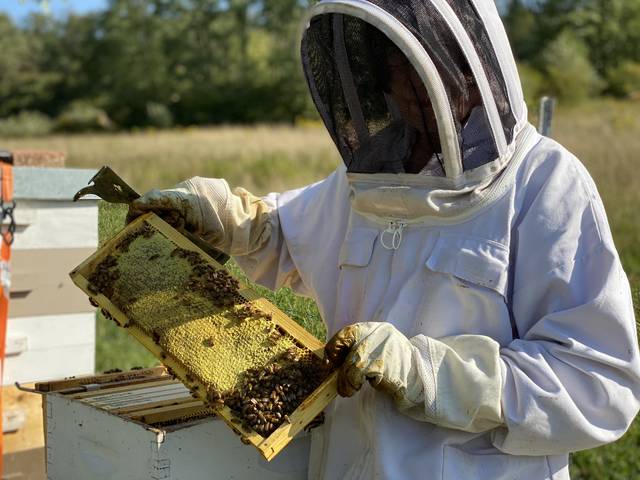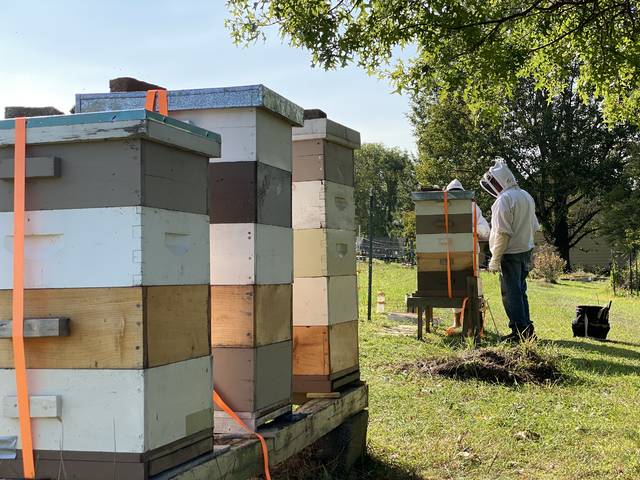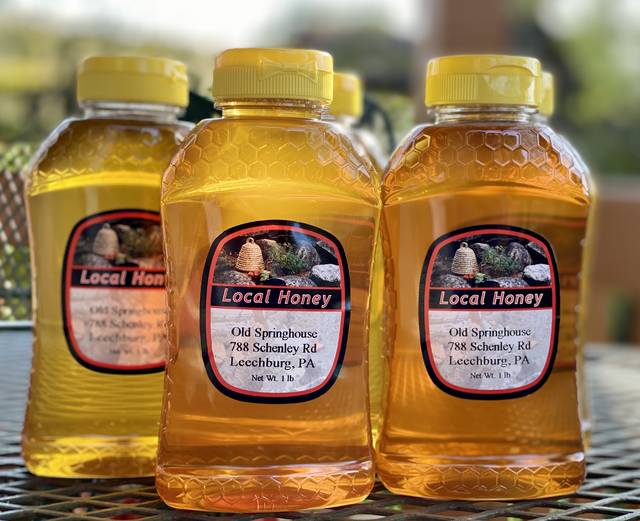Retired Gilpin couple's hobby keeps them busy as bees
Life is sweet for Jim and Sylvia Walters of Gilpin.
The retired couple took up beekeeping as a hobby about five years ago.
“We heard of the honeybees being in decline and wanted to do something. It wasn’t about the honey in the beginning. It was about helping the bees survive,” said Sylvia Walters, 71, a retired antiques store owner.
They’ve gotten a lot of information by watching YouTube videos.
They started with one hive, but things turned tragic during their first season.
“They all died,” Walters said. “I felt terrible. I didn’t know that they had to have the queen.”
The queen bee is essential. She lays eggs constantly to replace the other honeybees, which live only about a month.
“They just wear themselves out and die,” Walters said.
The honeybees are surviving these days as the couple tends to seven hives in three locations on their 100-acre farm.
Their bee season runs from March through October.
Right now, 20 acres of wild goldenrod growing on the property have the bees buzzing about as they prepare to go dormant for the winter in the hives, which remain on the property during winter. The Walterses added wind breaks and a bit of insulation to protect against freezing temperatures.
“I just like bees,” Walters said. “It’s amazing what they do.”
A roadside stand at the bottom of their driveway advertises their local honey for sale, bottled in small batches and sold for $10 a pound.
The couple hopes to produce enough honey to one day make a profit.
Initial beekeeping supplies cost about $500, Walters said.
“There’s always something that we need that we can’t afford yet,” she said.
The couple harvests honey in July and again in September.
“We have seven hives now, but it can quickly go to zero if things don’t go well,” Walters said, adding the bees can die.
Decked out in white full-body protective bee suits, Walters conducts daily hive inspections.
“I look to make sure that there is a viable queen and to see if the worker bees are bringing in pollen,” she said. “The queen’s job is to lay eggs.”
“I hate being hot in the bee suit in summer,” Walters said. “We usually split up the bee work into more than one day so it’s not so hard.”
Despite the hot suit, Walters said she looks forward to checking on her bee “babies.”
“I just love being with them,” Sylvia Walters said.
Data from a September report in Bee Culture, a national beekeeping trade journal, reported a 44% decrease in the national honey crop in 2020.
Ken Bowman, president of Beekeepers of ABCI, serving Armstrong, Butler, Indiana and Clarion counties, said two weather-related factors contributed to lower honey production.
“Here in Pennsylvania in 2020, because of extreme high temperatures in July and August, egg laying is reduced in a queen bee when the temperatures are above 90 degrees. And we had a lot of days this summer with temps over that. The other cause was a lack of rainfall. With moisture absent from the ground, the nectar in plants is reduced and the bees need water and moisture.”
Predators have yet to discover the hives, but the Walterses say bears frequent the area, and that’s a concern.
“We don’t have the money to install an electric fence around the hives; maybe someday,” Sylvia Walters said. “We have pictures of the bears coming right through our yard, and that’s one of the reasons we have the hives spaced out.”
Honey harvest averages about 100 pounds per season.
Honey flavors are directly related to the flower from which the bees collected.
Japanese knotweed is an invasive plant that commonly is seen growing along creeks and roadsides.
“Many times, it’s sprayed (with chemicals) by the government, but the bees love it and I view it as the best-tasting honey — so dark and rich in nutrition,” Walters said.
“Sucrose and fructose are the main sugars in honey, and the honey contains a lot of enzymes the honeybees make. Raw and minimally processed (not ultra-filtered) honey contain a lot of pollen, and people are of the opinion that the pollen desensitizes their allergic reaction to natural pollen,” Bowman said.
Jim Walters, the quiet half of the beekeeping team, said honey is a go-to food for him.
Sylvia credits her husband, Jim, with providing much needed muscle power.
“I couldn’t do this without Jim. He helps you with the physical aspect and the extractor and helps me with the bottling,” Sylvia said.
The Walterses are members of Beekeepers of ABCI and attend monthly meetings where they learn about beekeeping techniques.
They said they hope to sell more honey as production increases and participate in local farmers markets.
Joyce Hanz is a native of Charleston, S.C. and is a features reporter covering the Pittsburgh region. She majored in media arts and graduated from the University of South Carolina. She can be reached at jhanz@triblive.com
Remove the ads from your TribLIVE reading experience but still support the journalists who create the content with TribLIVE Ad-Free.




